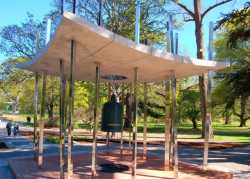Disarmament & Security Centre
In 1998, the Disarmament & Security Centre (DSC) was established as a specialist centre of the Peace Foundation, directed by Kate Dewes and Robert Green from their Christchurch home. Kate had previously coordinated the Peace Foundation's South Island office from her home from 1980-1998.
In 2004 the DSC became a separately incorporated body and remains a part of the wider Peace Foundation 'family'. It has its own Council and was named Te Whare Maukaroko (the House of Peace) by the DSC kaumatua (elder) and Maori chief Reverend Maurice Gray.
The broad objective of the DSC is to provide a resource centre for alternative thinking on disarmament and security issues, both within Aotearoa/New Zealand and internationally. Currently the work focuses on promoting the World Court's 1996 Advisory Opinion on nuclear weapons and its implications; exposing the fallacies of nuclear deterrence and offering safer alternative security strategies; promoting the United Nations Study on Disarmament and Non Proliferation Education; and implementing the Peace City recommendations adopted by the Christchurch City Council in May 2002.
Achievements include:
Participation in the Middle Powers Initiative (MPI) as members of its International Steering Committee; membership on MPI delegations to capitals lobbying on nuclear disarmament; writing briefing books and papers and speaking in UN fora.
Publishing books on nuclear deterrence; the World Court Project; and Pacific women and nuclear colonialism in the Pacific Region.
Teaching Peace Studies part-time at the University of Canterbury for 20 years.

Helping to establish Christchurch as New Zealandís first UNESCO City for Peace in 2002. Projects include the World Peace Bell in the Botanic Gardens; a Peace Walk around the city; formalising relationships with Hiroshima and Nagasaki; instigating the presentation of a sculpture from New Zealand and 6 cities to the Nagasaki Peace Park; Peace City Awards for local Peace makers, and a Peace City Website.
Staging photographic exhibitions with artefacts on the 1945 atomic bombings (from the Mayors of Hiroshima and Nagasaki); Mahatma Gandhi; and the health effects of Depleted Uranium Munitions. These are held in museums, galleries, public and university libraries and schools.
Organising and co-curating with Canterbury Museum a major exhibition celebrating the 20th anniversary of New Zealandís 1987 nuclear free legislation.
Co-production of Nuclear Free Nation, a CD+DVD compilation of New Zealand popular music and educational materials celebrating the 20th anniversary of the nuclear free legislation.
Organising New Zealandís most comprehensive peace and disarmament museum and library collections, based in Christchurch at Canterbury museum and the MacMillan Brown University and Christchurch City Libraries (oral, written, photographic and artefact collections).
Helping to organise and promote the documentary film Tau Te Mauri - Breath of Peace
Coordinating the Depleted Uranium Education Team (DUET) which organised a speaking tour in April 2005 by Dr Chris Busby, a leading British expert on health problems related to low-level radiation.
Maintaining New Zealandís most comprehensive peace and disarmament library and archive.
Distribution of the following disarmament education resources to most NZ high school libraries the Nuclear Free Nation CD+DVD compilation; the films Breath of Peace and Nuclear Reaction; the DSC publications Fast Track to Zero Nuclear Weapons; Aotearoa/New Zealand at the World Court and Pacific Women Speak Out for Independence and Denuclearisation; Elsie Lockeís Peace People and David Robieís Eyes of Fire.
Helping to establish the Aotearoa/New Zealand Centre for Peace and Conflict Studies at the University of Otago in 2008.
Membership of the Public Advisory Committee on Disarmament and Arms Control for 9 years from 1987-1990 and 2001-2007.
Appointment of DSC Director as member of UN Secretary Generalís Advisory Board on Disarmament Matters in 2008.
Working closely with Maori elders on peace issues including the Treaty of Waitangi and conflict resolution in prisons.
History of the PEACE FOUNDATION
